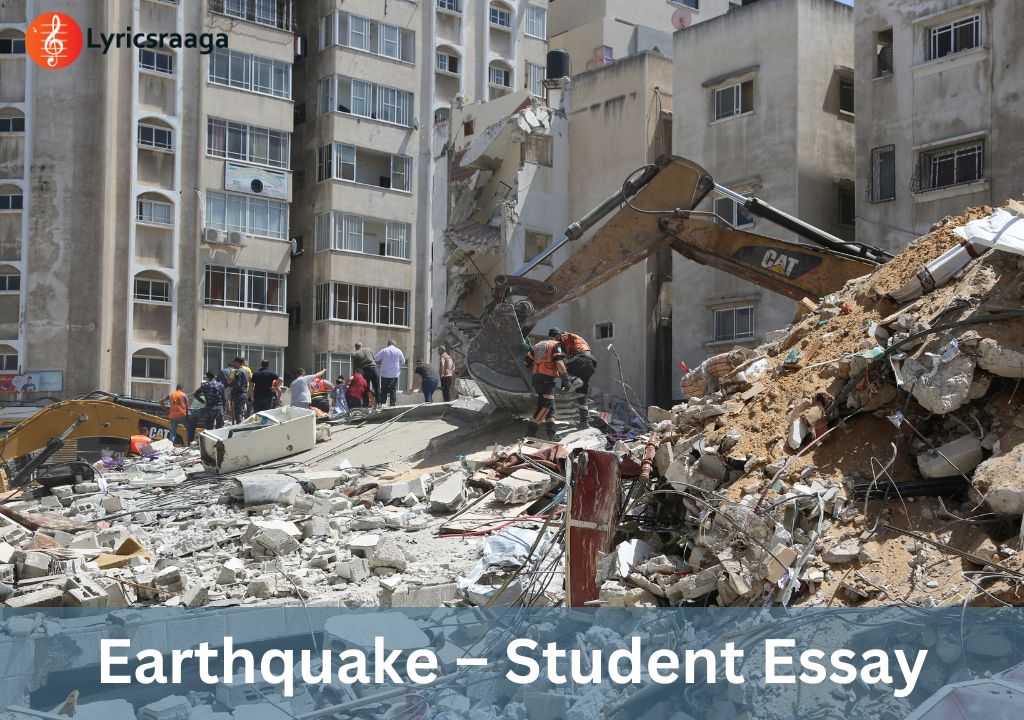Earthquake – Student Essay
Earthquake – Student Essay: The recent earthquake in Turkey and Syria, shook the world. The disaster took lives of hundred of people, made them homeless and few stuck under rubles fighting for lives. Its so heartbreaking to see and hear all these news. But we are very tiny living beings against Nature.
An earthquake is a natural disaster that can cause significant damage and loss of life. It is caused by the movement of tectonic plates in the Earth’s crust, resulting in the release of energy in the form of seismic waves.
The severity of an earthquake is measured using the Richter scale, which ranges from 1 to 10. The damage caused by an earthquake depends on several factors, including its magnitude, the type of soil, and the proximity to populated areas.
In areas where earthquakes are common, buildings and infrastructure are designed and constructed to withstand seismic activity. This includes the use of seismic-resistant materials, flexible building designs, and proper reinforcement of foundations and walls.
However, even with the best preparation and planning, earthquakes can still cause devastating damage. In the aftermath of an earthquake, rescue and relief efforts are crucial in providing assistance to those affected and rebuilding affected communities.
It is important for individuals and communities to educate themselves on earthquake safety measures and to have emergency plans in place in case of an earthquake. This includes having an emergency kit, knowing how to turn off gas and electricity, and knowing where to take shelter during an earthquake.
Additionally, earthquakes can trigger secondary hazards such as tsunamis, landslides, and fires. It is also important for communities to be prepared for these types of hazards and to have evacuation plans in place.
Early warning systems are also being developed in some countries to provide advanced notice of an impending earthquake, allowing for additional time for people to evacuate or take cover.
There are also efforts being made to predict earthquakes more accurately. Seismologists use various methods, such as monitoring changes in ground level, analyzing patterns in earthquake activity, and using seismic sensors, to attempt to predict earthquakes. However, the prediction of earthquakes remains a challenging task due to the complexity of the Earth’s crust and the unpredictable nature of tectonic plate movements.
It is also important for individuals to educate themselves about earthquake insurance and to consider purchasing coverage for their homes and belongings. This can provide financial protection in the event of earthquake damage and can help with the rebuilding process.
In conclusion, earthquakes are complex natural disasters that require ongoing preparation, education, and awareness to minimize the potential for damage and loss of life. It is crucial for individuals, communities, and governments to take a proactive approach to earthquake preparedness and response.
Top 10 most disastrous earthquakes in history
Here are ten of the most devastating earthquakes in history:
1. Sichuan, China, 2008: A magnitude 8.0 earthquake that struck Sichuan province in China resulted in over 87,000 deaths and left millions homeless.
2. Haiti, 2010: A magnitude 7.0 earthquake that struck Haiti resulted in over 200,000 deaths and widespread damage to infrastructure and buildings.
3. Indian Ocean, 2004: A magnitude 9.1 earthquake and subsequent tsunami caused widespread damage and loss of life across the Indian Ocean region, with over 230,000 deaths reported in 14 countries.
4. Japan, 2011: A magnitude 9.0 earthquake and subsequent tsunami struck Japan’s eastern coast, causing over 15,000 deaths and widespread damage to infrastructure and buildings.
5. Iran, 1990: A magnitude 7.7 earthquake that struck Iran resulted in over 50,000 deaths and extensive damage to buildings and infrastructure.
6. Tangshan, China, 1976: A magnitude 7.8 earthquake that struck Tangshan in China resulted in over 240,000
deaths and widespread damage to buildings and infrastructure.
7. Alaska, 1964: A magnitude 9.2 earthquake that struck Alaska was the largest recorded earthquake in North America and resulted in over 130 deaths and extensive damage.
8. Chile, 1960: A magnitude 9.5 earthquake that struck Chile was the largest recorded earthquake in the world and resulted in over 5,000 deaths and widespread damage.
9. Mexico City, 1985: A magnitude 8.1 earthquake that struck Mexico City resulted in over 10,000 deaths and widespread damage to buildings and infrastructure.
10. San Francisco, 1906: A magnitude 7.9 earthquake that struck San Francisco resulted in over 3,000 deaths and widespread damage to buildings and infrastructure.
These earthquakes demonstrate the potential for significant loss of life and damage that can result from earthquakes, and the importance of preparedness and response efforts to minimize the impacts of these disasters.
Precautions for earthquake
Here are some precautions that can be taken to prepare for and respond to an earthquake:
1. Create an emergency plan: Have a plan in place for what to do during and after an earthquake, including how to evacuate your home and where to meet with family members.
2. Assemble an emergency kit: Stock an emergency kit with food, water, medicine, first-aid supplies, and other essential items to last for at least three days.
3. Secure heavy objects: Secure heavy objects in your home, such as bookcases and appliances, to prevent them from falling and causing injury during an earthquake.
4. Identify safe places: Identify safe places in each room of your home, such as under a sturdy desk or table, where you can take cover during an earthquake.
5. Know how to turn off gas and electricity: Know how to turn off the gas and electricity in your home to prevent fires or explosions in the event of damage to the gas or electrical systems.
6. Practice earthquake drills: Practice earthquake drills with your family so that everyone knows what to do during an earthquake.
7. Retrofit your home: Consider retrofitting your home with seismic-resistant materials and proper reinforcement of foundations and walls to increase its resistance to earthquake damage.
8. Purchase earthquake insurance: Consider purchasing earthquake insurance to provide financial protection in the event of earthquake damage to your home or belongings.
9. Stay informed: Stay informed about the latest earthquake warnings and updates through local news and emergency management agencies.
By taking these precautions, you can increase your preparedness for an earthquake and reduce the potential for damage and injury.




